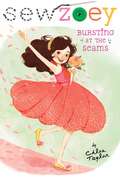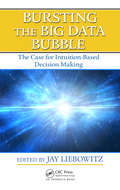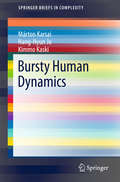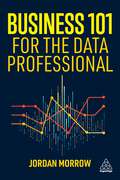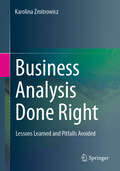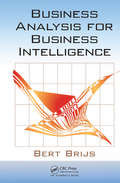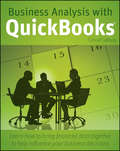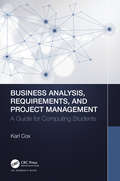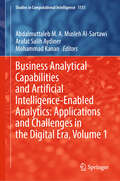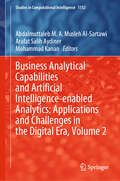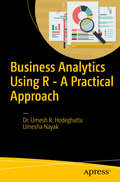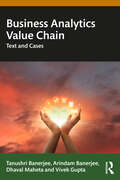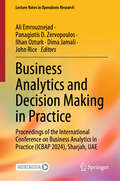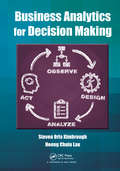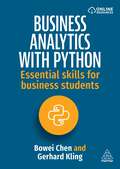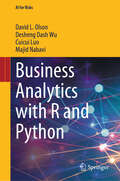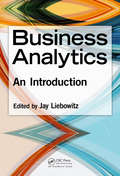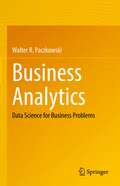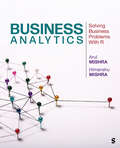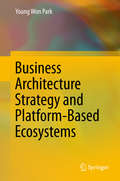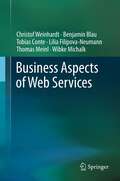- Table View
- List View
Bursting at the Seams
by Nancy Zhang Chloe TaylorZoey's aunt is throwing a surprise wedding, and wants Zoey to make her dress! Can Zoey keep it a secret until the big day? Includes "Sew Zoey" blog posts and fashion illustrations.In the tenth book in the Sew Zoey series, Zoey's aunt lets Zoey in on a very big secret: She and her fiancé are throwing a surprise wedding! She asks Zoey to make the wedding dress and be a junior bridesmaid. Zoey is so excited about the wedding she could burst--but can't say a word to anyone except her dad and Marcus. At school, Zoey has some new sewing competition: A boy in her new Home Economics unit is sewing circles around her, and is a strong competitor for a class sewing contest. For the sake of the wedding, can Zoey let go of her desire to win the competition?
Bursting the Big Data Bubble: The Case for Intuition-Based Decision Making
by Jay LiebowitzAs we get caught up in the quagmire of big data and analytics, it is important to be able to reflect and apply insights, experience, and intuition as part of the decision-making process. This book focuses on this intuition-based decision making. The first part of the book presents contributions from leading researchers worldwide on the topic of intuition-based decision making as applied to management. In the second part, executives and senior managers in industry, government, universities, and not-for-profits present vignettes that illustrate how they have used intuition in making key decisions.
Bursty Human Dynamics (SpringerBriefs in Complexity)
by Márton Karsai Hang-Hyun Jo Kimmo KaskiThis book provides a comprehensive overview on emergent bursty patterns in the dynamics of human behaviour. It presents common and alternative understanding of the investigated phenomena, and points out open questions worthy of further investigations. The book is structured as follows. In the introduction the authors discuss the motivation of the field, describe bursty phenomena in case of human behaviour, and relate it to other disciplines. The second chapter addresses the measures commonly used to characterise heterogeneous signals, bursty human dynamics, temporal paths, and correlated behaviour. These definitions are first introduced to set the basis for the discussion of the third chapter about the observations of bursty human patterns in the dynamics of individuals, dyadic interactions, and collective behaviour. The subsequent fourth chapter discusses the models of bursty human dynamics. Various mechanisms have been proposed about the source of the heterogeneities in human dynamics, which leads to the introduction of conceptually different modelling approaches. The authors address all of these perspectives objectively, highlight their strengths and shortcomings, and mention possible extensions to them. The fifth chapter addresses the effect of individual heterogeneous behaviour on collective dynamics. This question in particular has been investigated in various systems including spreading phenomena, random walks, and opinion formation dynamics. Here the main issues are whether burstiness speeds up or slows down the co-evolving processes, and how burstiness modifies time-dependent paths in the system that determine the spreading patterns of any kind of information or influence. Finally in the sixth chapter the authors end the review with a discussion and future perspectives. It is an ideal book for researchers and students who wish to enter the field of bursty human dynamics or want to expand their knowledge on such phenomena.
Business 101 for the Data Professional: What You Need to Know to Succeed in Business
by Jordan MorrowThis new book from bestselling author Jordan Morrow empowers data professionals to work and operate more effectively in an organizational setting, equipping them with key business knowledge and skills.It is vital for data professionals to understand the business needs and outcomes of the organizations they work for and collaborate effectively with non-technical colleagues. Business 101 for the Data Professional is the definitive guide for data professionals looking to upskill their organizational effectiveness and enhance their career prospects. From business strategy to different business areas such as product, marketing, sales and operations to data monetization and value, the book explains how these contribute to the business, and, crucially, the role that data plays in supporting them. Business 101 for the Data Professional explores how to navigate key challenges and pitfalls of data in business, such as bias, misuse of data and the balancing of data and technical debt. It shows how to build networking, influencing and relationship building skills and outlines the key principles of strong communication and data storytelling, explaining how these can be used to engage effectively with internal and external stakeholders such as clients. It is supported by examples, summaries of key learnings, and exercises at the end of each chapter to help readers detail their progress and map out their goals.
Business Analysis Done Right: Lessons Learned and Pitfalls Avoided
by Karolina ZmitrowiczThis book presents observations, experiences, and practices that work or don't work in different areas of business analysis – combining the lessons learned with how to avoid potential pitfalls. Four areas were identified that constitute the greatest project challenges and the most frequently occurring problems in the work of a business analyst: strategic analysis, business analysis process planning, requirements engineering, and solution implementation. These areas hence build the main chapters of this book. Each of them begins with a brief introduction explaining the essence of the respective area and presenting the most important information. They are further divided into sections describing specific topics, where tips and recommendations are presented. Most sections begin with a guiding thought - a quote provided by an expert or a short hint based on the author’s 20 years of experience. At the end of each chapter, case studies and/or checklists are provided facilitating the planning and implementation of business analysis practice in a project. This book provides readers with suggestions, ideas, and conclusions regarding selected aspects of business analysis - in particular, discussing challenges and recommendations regarding the application of specific methods, practices in specific usage contexts. It will be most beneficial to professionals who already have a basic understanding of the fundamentals of business analysis and will be able to relate theoretical knowledge to practical examples of project applications. Readers who are just entering the field of business analysis will also benefit by gaining insights how to avoid basic mistakes or risks.
Business Analysis for Business Intelligence
by Bert BrijsAligning business intelligence (BI) infrastructure with strategy processes not only improves your organization's ability to respond to change, but also adds significant value to your BI infrastructure and development investments. Until now, there has been a need for a comprehensive book on business analysis for BI that starts with a macro view and
Business Analysis with QuickBooks
by Conrad CarlbergManage your business and make sound decisions with the help of QuickBooksQuickbooks is a user-friendly accounting software program that can analyze data to help you make smart decisions for a small- or medium-sized business. However, few books explain how to maximize the features of QuickBooks reports for management purposes-until now. Author Conrad Carlberg guides you through the most beneficial ways to use and adapt QuickBooks reports by taking the summary data and placing it into a context that helps manage a business.By avoiding aiming the coverage to a specific version of QuickBooks, this book is a timeless resource that clearly explains how to bring financial data together in order to help make wise business decisions.Use the popular accounting software program QuickBooks to help you make wise business management decisionsIdentify specific weak points in a business and learn how to turn them aroundQuantify working capital and manage inventory valuation properlyLearn how to understand what QuickBook reports say about the state of your business now and for the futureQuickly get started converting QuickBooks accounting data into results that help you make informed business decisions and manage your business.
Business Analysis, Requirements, and Project Management: A Guide for Computing Students
by Karl CoxIT projects emerge from a business need. In practice, software developers must accomplish two big things before an IT project can begin: find out what you need to do (i.e., analyse business requirements) and plan out how to do it (i.e., project management). The biggest problem in IT projects is delivering the wrong product because IT people do not understand what business people require. This practical textbook teaches computer science students how to manage and deliver IT projects by linking business and IT requirements with project management in an incremental and straightforward approach. Business Analysis, Requirements, and Project Management: A Guide for Computing Students presents an approach to analysis management that scales the business perspective. It takes a business process view of a business proposal as a model and explains how to structure a technical problem into a recognisable pattern with problem frames. It shows how to identify core transactions and model them as use cases to create a requirements table useful to designers and coders. Linked to the analysis are three management tools: the product breakdown structure (PBS), the Gantt chart, and the Kanban board. The PBS is derived in part from the problem frame. The Gantt chart emerges from the PBS and ensures the key requirements are addressed by reference to use cases. The Kanban board is especially useful in Task Driven Development, which the text covers. This textbook consists of two interleaving parts and features a single case study. Part one addresses the business and requirements perspective. The second integrates core project management approaches and explains how both requirements and management are connected. The remainder of the book is appendices, the first of which provides solutions to the exercises presented in each chapter. The second appendix puts together much of the documentation for the case study into one place. The case study presents a real-word business scenario to expose students to professional practice.
Business Analytical Capabilities and Artificial Intelligence-Enabled Analytics: Applications and Challenges in the Digital Era, Volume 1 (Studies in Computational Intelligence #1151)
by Abdalmuttaleb M. A. Musleh Al-Sartawi Arafat Salih Aydiner Mohammad KananThis book explores and discusses how businesses transit from big data and business analytics to artificial intelligence (AI), by examining advanced technologies and embracing challenges such as ethical issues, governance, security, privacy, and interoperability of capabilities. This book covers a range of topics including the application of cyber accounting and strategic objectives, financial inclusion, big data analytics in telecommunication sector, digital marketing strategies and sports brand loyalty, robotic processes automation in banks, and the applications of AI for decision-making in human resources, healthcare, banking, and many more. The book provides a comprehensive reference for scholars, students, managers, entrepreneurs, and policymakers by examining frameworks and business practice implications through its discussions which embrace a wide variety of unique topics on business analytics, AI, and how it can be applied together to address the challenges of the digital era.
Business Analytical Capabilities and Artificial Intelligence-enabled Analytics: Applications and Challenges in the Digital Era, Volume 2 (Studies in Computational Intelligence #1152)
by Abdalmuttaleb M. A. Musleh Al-Sartawi Arafat Salih Aydiner Mohammad KananThis book explores and discusses how businesses transit from big data and business analytics to artificial intelligence (AI), by examining advanced technologies and embracing challenges such as ethical issues, governance, security, privacy, and interoperability of capabilities. This book covers a range of topics including the application of cyber accounting and strategic objectives, financial inclusion, big data analytics in telecommunication sector, digital marketing strategies and sports brand loyalty, robotic processes automation in banks, and the applications of AI for decision-making in human resources, healthcare, banking, and many more. The book provides a comprehensive reference for scholars, students, managers, entrepreneurs, and policymakers by examining frameworks and business practice implications through its discussions which embrace a wide variety of unique topics on business analytics, AI, and how it can be applied together to address the challenges of the digital era.
Business Analytics Using R - A Practical Approach: A Practical Approach
by Umesh R. Hodeghatta Umesh NayakLearn the fundamental aspects of the business statistics, data mining, and machine learning techniques required to understand the huge amount of data generated by your organization. This book explains practical business analytics through examples, covers the steps involved in using it correctly, and shows you the context in which a particular technique does not make sense. Further, Practical Business Analytics using R helps you understand specific issues faced by organizations and how the solutions to these issues can be facilitated by business analytics. This book will discuss and explore the following through examples and case studies: An introduction to R: data management and R functions The architecture, framework, and life cycle of a business analytics project Descriptive analytics using R: descriptive statistics and data cleaning Data mining: classification, association rules, and clustering Predictive analytics: simple regression, multiple regression, and logistic regression This book includes case studies on important business analytic techniques, such as classification, association, clustering, and regression. The R language is the statistical tool used to demonstrate the concepts throughout the book. What You Will Learn * Write R programs to handle data * Build analytical models and draw useful inferences from them * Discover the basic concepts of data mining and machine learning * Carry out predictive modeling * Define a business issue as an analytical problem Who This Book Is For Beginners who want to understand and learn the fundamentals of analytics using R. Students, managers, executives, strategy and planning professionals, software professionals, and BI/DW professionals.
Business Analytics Value Chain: Text and Cases
by Tanushri Banerjee Arindam Banerjee Dhaval Maheta Vivek GuptaThis book is a comprehensive, step-by-step learning guide towards understanding an entire value chain of Business Analytics, its interrelated components and its role in business decision-making in India and globally. The book has been written with an interdisciplinary approach that triggers strategic as well as routine, thought-provoking ideas to cut across data from several business domains globally.Business Analytics Value Chain deals with the end-to-end journey from planning the approach to a data enriched decision-problem, to communicating results derived from analytics models to clients. Using current cases from all aspects of a business venture (finance, marketing, human resources, and operations), the book helps the readers to develop the capabilities of evaluating a business case scenario; understand the business problem; identify the data sources and data availability; logically think through problemsolving; use analytics techniques and application software to solve the problem; and be able to interpret the results. Case studies have been carefully designed to represent business scenarios from varied business domains, both local and global, such that they guide the students to making informed fact-based decisions during collaborative planning, analyzing, interpreting, and communicating outcomes for data-enriched problem scenarios.The book will be useful for students, researchers, and instructors from the fields of Business Management, Data Analytics, Commerce, and Economics. It will also be an indispensable companion to the professional working in the field of data analytics.
Business Analytics and Decision Making in Practice: Proceedings of the International Conference on Business Analytics in Practice (ICBAP 2024), Sharjah, UAE (Lecture Notes in Operations Research)
by Ali Emrouznejad Dima Jamali John Rice Panagiotis D. Zervopoulos Ilhan OzturkThis book presents selected proceedings of the International Conference on Business Analytics in Practice (ICBAP2024), which was held on January 8–11, 2024, at the University of Sharjah, UAE. The book presents advanced modeling and examples to explore the practical applications of business analytics across various industries and domains. In addition, it dives deep into the world of data-driven decision-making, showcasing real-world case studies and best practices to illustrate how organizations can harness the power of analytics to optimize their decision-making processes. From descriptive analytics to predictive modeling and prescriptive analytics, readers will gain valuable insights into the different techniques and methodologies employed in business analytics.
Business Analytics for Decision Making
by Steven Orla Kimbrough Hoong Chuin LauBusiness Analytics for Decision Making, the first complete text suitable for use in introductory Business Analytics courses, establishes a national syllabus for an emerging first course at an MBA or upper undergraduate level. This timely text is mainly about model analytics, particularly analytics for constrained optimization. It uses implementations that allow students to explore models and data for the sake of discovery, understanding, and decision making.Business analytics is about using data and models to solve various kinds of decision problems. There are three aspects for those who want to make the most of their analytics: encoding, solution design, and post-solution analysis. This textbook addresses all three. Emphasizing the use of constrained optimization models for decision making, the book concentrates on post-solution analysis of models. The text focuses on computationally challenging problems that commonly arise in business environments. Unique among business analytics texts, it emphasizes using heuristics for solving difficult optimization problems important in business practice by making best use of methods from Computer Science and Operations Research. Furthermore, case studies and examples illustrate the real-world applications of these methods. The authors supply examples in Excel®, GAMS, MATLAB®, and OPL. The metaheuristics code is also made available at the book's website in a documented library of Python modules, along with data and material for homework exercises. From the beginning, the authors emphasize analytics and de-emphasize representation and encoding so students will have plenty to sink their teeth into regardless of their computer programming experience.
Business Analytics with Python: Essential Skills for Business Students
by Bowei Chen Gerhard KlingData-driven decision-making is a fundamental component of business success. Use this textbook to help you learn and understand the core knowledge and techniques needed for analysing business data with Python programming. Business Analytics with Python is ideal for students taking upper level undergraduate and postgraduate modules on analytics as part of their business, management or finance degrees. It assumes no prior knowledge or experience in computer science, instead presenting the technical aspects of the subject in an accessible, introductory way for students. This book takes a holistic approach to business analytics, covering not only Python as well as mathematical and statistical concepts, essential machine learning methods and their applications.Features include:- Chapters covering preliminaries, as well as supervised and unsupervised machine learning techniques- A running case study to help students apply their knowledge in practice.- Real-life examples demonstrating the use of business analytics for tasks such as customer churn prediction, credit card fraud detection, and sales forecasting.- Practical exercises and activities, learning objectives, and chapter summaries to support learning.
Business Analytics with R and Python (AI for Risks)
by David L. Olson Desheng Dash Wu Cuicui Luo Majid NabaviThis book provides an overview of data mining methods in the field of business. Business management faces challenges in serving customers in better ways, in identifying risks, and analyzing the impact of decisions. Of the three types of analytic tools, descriptive analytics focuses on what has happened and predictive analytics extends statistical and/or artificial intelligence to provide forecasting capability. Chapter 1 provides an overview of business management problems. Chapter 2 describes how analytics and knowledge management have been used to better cope with these problems. Chapter 3 describes initial data visualization tools. Chapter 4 describes association rules and software support. Chapter 5 describes cluster analysis with software demonstration. Chapter 6 discusses time series analysis with software demonstration. Chapter 7 describes predictive classification data mining tools. Applications of the context of management are presented in Chapter 8. Chapter 9 covers prescriptive modeling in business and applications of artificial intelligence.
Business Analytics: An Introduction
by Jay LiebowitzTogether, Big Data, high-performance computing, and complex environments create unprecedented opportunities for organizations to generate game-changing insights that are based on hard data. Business Analytics: An Introduction explains how to use business analytics to sort through an ever-increasing amount of data and improve the decision-making cap
Business Analytics: Data Science for Business Problems
by Walter R. PaczkowskiThis book focuses on three core knowledge requirements for effective and thorough data analysis for solving business problems. These are a foundational understanding of: 1. statistical, econometric, and machine learning techniques; 2. data handling capabilities; 3. at least one programming language. Practical in orientation, the volume offers illustrative case studies throughout and examples using Python in the context of Jupyter notebooks. Covered topics include demand measurement and forecasting, predictive modeling, pricing analytics, customer satisfaction assessment, market and advertising research, and new product development and research. This volume will be useful to business data analysts, data scientists, and market research professionals, as well as aspiring practitioners in business data analytics. It can also be used in colleges and universities offering courses and certifications in business data analytics, data science, and market research.
Business Analytics: Solving Business Problems With R
by Arul Mishra Himanshu MishraBusinesses typically encounter problems first and then seek out analytical methods to help in decision making. Business Analytics: Solving Business Problems with R by Arul Mishra and Himanshu Mishra offers practical, data-driven solutions for today′s dynamic business environment. This text helps students see the real-world potential of analytical methods to help meet their business challenges by demonstrating the application of crucial methods. These methods are cutting edge, including neural nets, natural language processing, and boosted decision trees. Applications throughout the book, including pricing models, social sentiment analysis, and branding show students how to use these analytical methods in real business settings, including Frito-Lay, Netflix, and Zappos. Step-by-step R code with commentary gives readers the tools to adapt each method to their business settings. The book offers comprehensive coverage across diverse business domains, including finance, marketing, human resources, operations, and accounting. Finally, an entire chapter explores equity and fairness in analytical methods, as well as the techniques that can be used to mitigate biases and enhance equity in the results. Included with this title: LMS Cartridge: Import this title’s instructor resources into your school’s learning management system (LMS) and save time. Don’t use an LMS? You can still access all of the same online resources for this title via the password-protected Instructor Resource Site.
Business Analytics: Solving Business Problems With R
by Arul Mishra Himanshu MishraBusinesses typically encounter problems first and then seek out analytical methods to help in decision making. Business Analytics: Solving Business Problems with R by Arul Mishra and Himanshu Mishra offers practical, data-driven solutions for today′s dynamic business environment. This text helps students see the real-world potential of analytical methods to help meet their business challenges by demonstrating the application of crucial methods. These methods are cutting edge, including neural nets, natural language processing, and boosted decision trees. Applications throughout the book, including pricing models, social sentiment analysis, and branding show students how to use these analytical methods in real business settings, including Frito-Lay, Netflix, and Zappos. Step-by-step R code with commentary gives readers the tools to adapt each method to their business settings. The book offers comprehensive coverage across diverse business domains, including finance, marketing, human resources, operations, and accounting. Finally, an entire chapter explores equity and fairness in analytical methods, as well as the techniques that can be used to mitigate biases and enhance equity in the results. Included with this title: LMS Cartridge: Import this title’s instructor resources into your school’s learning management system (LMS) and save time. Don’t use an LMS? You can still access all of the same online resources for this title via the password-protected Instructor Resource Site.
Business Architecture Strategy and Platform-Based Ecosystems
by Young Won ParkThis book provides a framework and real case analyses concerning business architecture strategy and platform-based ecosystems. Firstly, the book introduces a framework of business architecture strategy and suggests an engineering process that employs a business architecture analysis system in which the various business best-practices information technology (IT) tools are integrated into an interface. More specifically, this architecture analysis provides the means to realize two essential features: a strategy that allows global firms to sense changing market needs, and a tool that combines mechanical engineering with electronics and software IT tools. Secondly, the book discusses platform-based ecosystems. Crucial issues for today's firms are associated with value creation through their platform and ecosystem framework. With a major emphasis on modular product architecture, US firms have focused heavily on platform development in modular industries. Their base is operation system (OS) software, so that IT firms in general focus on software capabilities--and digital control in particular. In contrast, the advantage for Japanese firms is not digital but analog control. Without any drastic changes in their industry practices, Japanese firms are likely to sustain their analog platform advantage. The book subsequently puts forward a holistic view through the connection of business architecture strategy and platform-based ecosystems. The theoretical framework and case illustrations are especially useful to firms involved in a variety of industries that must respond to the turbulent environmental changes of the digital era. Most of the cases target not only Japanese firms but also many other global firms. Readers are systematically shown how to balance technological competence and customer competence by using the framework of business architecture strategy and platform-based ecosystems.
Business Aspects of Web Services
by Benjamin Blau Christof Weinhardt Wibke Michalk Lilia Filipova-Neumann Thomas Meinl Tobias ConteDriven by maturing Web service technologies and the wide acceptance of the service-oriented architecture paradigm, the software industry's traditional business models and strategies have begun to change: software vendors are turning into service providers. In addition, in the Web service market, a multitude of small and highly specialized providers offer modular services of almost any kind and economic value is created through the interplay of various distributed service providers that jointly contribute to form individualized and integrated solutions. This trend can be optimally catalyzed by universally accessible service orchestration platforms - service value networks (SVNs) - which are the underlying organizational form of the coordination mechanisms presented in this book. Here, the authors focus on providing comprehensive business-oriented insights into today's trends and challenges that stem from the transition to a service-led economy. They investigate current and future Web service business models and provide a framework for Web service value networks. Pricing mechanism basics are introduced and applied to the specific area of SVNs. Strategies for platform providers are analyzed from the viewpoint of a single provider, and so are pricing mechanisms in service value networks which are optimal from a network perspective. The extended concept of pricing Web service derivatives is also illustrated. The presentation concludes with a vision of how Web service markets in the future could be structured and what further developments can be expected to happen. This book will be of interest to researchers in business development and practitioners such as managers of SMEs in the service sector, as well as computer scientists familiar with Web technologies. The book's comprehensive content provides readers with a thorough understanding of the organizational, economic and technical implications of dealing with Web services as the nucleus of modern business models, which can be applied to Web services in general and Web service value networks specifically..
Business Case Analysis with R: Simulation Tutorials To Support Complex Business Decisions
by Robert D. Brown IIIThis tutorial teaches you how to use the statistical programming language R to develop a business case simulation and analysis. It presents a methodology for conducting business case analysis that minimizes decision delay by focusing stakeholders on what matters most and suggests pathways for minimizing the risk in strategic and capital allocation decisions. Business case analysis, often conducted in spreadsheets, exposes decision makers to additional risks that arise just from the use of the spreadsheet environment. R has become one of the most widely used tools for reproducible quantitative analysis, and analysts fluent in this language are in high demand. The R language, traditionally used for statistical analysis, provides a more explicit, flexible, and extensible environment than spreadsheets for conducting business case analysis. The main tutorial follows the case in which a chemical manufacturing company considers constructing a chemical reactor and production facility to bring a new compound to market. There are numerous uncertainties and risks involved, including the possibility that a competitor brings a similar product online. The company must determine the value of making the decision to move forward and where they might prioritize their attention to make a more informed and robust decision. While the example used is a chemical company, the analysis structure it presents can be applied to just about any business decision, from IT projects to new product development to commercial real estate. The supporting tutorials include the perspective of the founder of a professional service firm who wants to grow his business and a member of a strategic planning group in a biomedical device company who wants to know how much to budget in order to refine the quality of information about critical uncertainties that might affect the value of a chosen product development pathway. What You’ll LearnSet up a business case abstraction in an influence diagram to communicate the essence of the problem to other stakeholdersModel the inherent uncertainties in the problem with Monte Carlo simulation using the R languageCommunicate the results graphicallyDraw appropriate insights from the resultsDevelop creative decision strategies for thorough opportunity cost analysisCalculate the value of information on critical uncertainties between competing decision strategies to set the budget for deeper data analysisConstruct appropriate information to satisfy the parameters for the Monte Carlo simulation when little or no empirical data are available Who This Book Is For Financial analysts, data practitioners, and risk/business professionals; also appropriate for graduate level finance, business, or data science students
Business Computer Information Systems I (Texas Edition)
by Prentice HallBusiness Computer information Systems I presents the basic concepts and skills of Microsoft Office XP (Microsoft Word, Microsoft Excel, Microsoft Access, Microsoft PowerPoint and Microsoft Outlook and also introduces fundamental computer concepts.
Business Computer Information Systems II (Texas Edition)
by Pearson EducationBusiness Computer Information Systems II presents advanced concepts and skills of Microsoft Office XP (Microsoft Word, Microsoft Excel, Microsoft Access, and Microsoft Outlook®). Through a learn-by-doing approach, students are challenged to master Microsoft Office within a business context. Additional features throughout the book also provide insight into how software can be used in other academic areas and in the business world.
